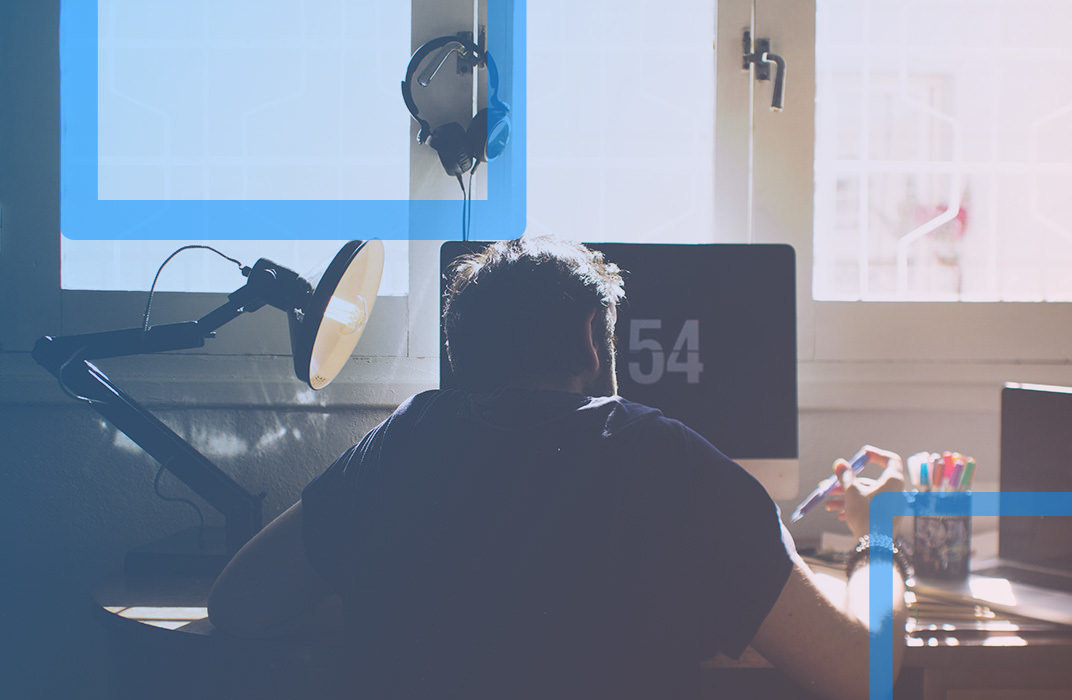Greatness takes more than just hard work.
How do we make sure we’re not just doing good work, but doing work that has the potential to be truly great? Edison said that genius is 99% perspiration and 1% inspiration. Newton said that if others would work as hard as he did, they would get similar results. And while hard work is definitely part of the equation, it’s not all there is. In his paper A stroke of genius: Striving for greatness in all you do, multi-award winning scientist, engineer, and writer Dr. Richard Hamming put together a simple formula for doing great work:“If you are to do important work then you must work on the right problem at the right time and in the right way. Without any of the three, you may do good work but you will almost certainly miss real greatness.”Dr. Richard HammingSolving the right problems. Committing to big ideas. Sharing your work. Getting feedback from your community. All of these will help you ensure that you’re doing the right work at the right time. But what about working the right way? Over the past 4 years of running CloudDevs, we’ve obsessed over finding the best ways to work, not just for ourselves, but for all of the freelance designers and developers in our network—from not working set hours to embracing remote culture to creating systems and processes that help everyone do their best work time and time again. So, with another year of great work ahead of us, we’ve put together 10 of the most impactful thoughts about how to work right.
On getting started
Every single day we choose how to spend what few hours we have. Yet, despite the constant warnings to spend them chasing after what we believe, we often fall victim to procrastination and a fear of even just starting. Behavioral economists call this Time Inconsistency—the human brain’s tendency to value immediate rewards more highly than future rewards. When we’re focusing on our work, it can be easy to get swept away by small tasks: Emails, notifications, busy work. Life is so much more simple when you only look at the rock in front of you instead of straining to see the mountain off in the distance. But even taking that first step towards a bigger goal can create massive change. There’s a mental process called the Zeigarnik Effect, which kicks in when you are close to finishing a task, propelling you towards the finish line like you’re running from a hoard of zombies. And if that doesn’t help get you started, just remember these words from writer and theorist Eliezer Yudkowsky:“On a moment-to-moment basis, being in the middle of doing the work is usually less painful than being in the middle of procrastinating.”Eliezer Yudowsky
On building the right habits
Greatness needs a solid foundation to build on. As the forefather of productivity, Jim Rohn, explained: “Success is nothing more than a few simple disciplines, practiced every day.” But building good working habits is difficult. Especially when we’re feeling uninspired or the end results feel too far off to be real. So we need to start small. Every habit you want to build can be broken down into a sequence of steps. For example, a gym workout can be broken down into the following steps: getting off your butt, changing your clothes, putting a gym bag together, traveling to the gym, doing your workout, showering, and going home. But our brains love the path of least resistance, so all those steps before and after the actual process of working out? They put a barrier between us and our goals. So we need to simplify the process. One of our favorite techniques is what Stanford professor and psychologist BJ Fogg calls ‘designing for laziness’. Basically, set yourself up so that the easiest task is the most important one. For example:- Turn off your phone and put it in a drawer
- Unplug your TV and put it in the closet
- Close all browser tabs except the one you need for the next morning
On having rituals as well as routines
In one of his most influential essays, essayist, programmer, and venture capitalist Paul Graham proposed that there are two very different ways of scheduling your work day:“The manager’s schedule is for bosses. It’s embodied in the traditional appointment book, with each day cut into one hour intervals… When you use time that way, it’s merely a practical problem to meet with someone. Find an open slot in your schedule, book them, and you’re done. But there’s another way of using time that’s common among people who make things, like programmers and writers. They generally prefer to use time in units of half a day at least. You can’t write or program well in units of an hour. That’s barely enough time to get started.”Unfortunately, most of us sit in the middle, spending part of our day working on important tasks and then being forced to flip back to ‘manager’ mode. But as we all know, the brain can’t multi-task. Some studies even say it can take up to 25 minutes for us to regain our focus after a disruption. Which is why we need to respect the time to create and do great work. For Brainpicking’s founder Maria Popova,this means building rituals as well as routines.
“While routine aims to make the chaos of everyday life more containable and controllable, ritual aims to imbue the mundane with an element of the magical.”?Maria PopovaA ritual is personal. It can be anything from the cup you use to drink your coffee from to the music you listen to. Hell, Beethoven had to count out precisely 60 beans for his morning coffee before starting to work. What’s important is that it signals that this is time to focus on the important work. Once you know your ritual, you’ll be able to use it to push yourself into creation mode.
On managing your time
Ironically, you can waste more time reading about time management than anything else. When it comes to doing your best work there are only two important things to remember: automate and group tasks. To overcome decision fatigue and be more productive in general, Tim Ferriss recommends putting systems and processes in place that automate as much thinking as possible.“Success is nothing more than a few simple disciplines, practiced every day.”Jim RohnThe goal is to turn open-ended questions (What am I going to eat for breakfast?) into if/then statements (If it’s a weekday, I’m going to have oatmeal for breakfast). This way, you save your willpower and decision making for the tasks that matter. When it comes to how to schedule your day, we follow the lead of designer and writer Paul Jarvis, who groups similar tasks together during his week. For example, if he’s focused on writing he’ll crank out 3–4 posts at a time rather than just trying to finish one each day. This helps his brain enter ‘writing mode’. For more ideas, check out these 5 unconventional ways to manage your time, and these methods for creating to-do lists that won’t make you sad.
On fighting procrastination
“The quality of creative ideas,” writes Harvard-trained psychologist Keith Simonton, “is a positive function of quantity”. In other words, to be creative and do great work, we need to buckle down and do more of it. Consultant-turned-school teacher Angela Duckworth calls this quality grit, and suggests that it’s the number one predictor of future success in anyone. Grit, as Angela describes it, is “passion and perseverance for very long-term goals.” It’s having stamina and sticking with your vision of the future, day-in, day-out, not just for the week or month, but for years. The way to develop grit, and in turn fight procrastination and a lack of motivation, is to build a growth mindset—one where we believe that learning is a life-long endeavour and, even more importantly, that failure isn’t a permanent condition. Great work comes from output, and believing it’s okay to fail in interesting ways is a great way to force you to create and push beyond where you are, rather than hide behind past accomplishments. Or, as Biz Stone, co-founder of Twitter, explains: success is partially luck…“but I like to say that timing, perseverance, and 10 years of really hard work will eventually make you look like an overnight success.”Biz Stone
On creating the right work environment
While startups are installing slides, ping-pong tables, and nap rooms, some of the most innovative and successful people have found inspiration in beach huts, basements, and bars. While doing great work isn’t location dependent, having a space that consistently inspires is still incredibly important. So when you’re feeling a lack of motivation, there are ways to quickly make you’re you’re in a space that works for you. Here’s a few: Get rid of the clutter: While Einsten argued “If a cluttered desk signs a cluttered mind, of what, then, is an empty desk a sign?” the realities are that clutter distracts, confuses, and can even cause us physical pain. Search for sunlight: It’s been long known that schools with more natural light provide a better learning environment for students and test scores often go up as a result. And natural light and fresh air are known to stimulate productivity in the workplace as well. Curate your senses: Beyond the physical layout and mental associations of your space the sounds around you can have a huge impact on your productivity. Here’s our guide to creating the right playlist for your workday.On giving yourself breaks
When the excitement is bubbling and you feel you’re about to make that big breakthrough, the last thing on your mind is stopping work. But taking regular breaks is one of the best ways to avoid burnout, boost your energy, and discover new ways to tackle the issue at hand. Ironically, they even help you to stay focused, according to University of Illinois psychology professor Alejandro Lleras who found that deactivating and reactivating your goals allows you to actually stay more focused.“When you work on a task continuously, it’s easy to lose focus and get lost in the weeds.”Entrepreneur Jason Zook schedules breaks into his day beyond just time for meals. Each one is deliberately set during a time you’d otherwise be working and are a 10–30 minute break away from technology to recharge and refocus. For more ideas of how to take breaks, try going for a walk, reading a book, meditating, or even just letting your mind wander.
On giving up on the idea of ‘perfection’
As we said before, great work comes from being okay with failing in an interesting way. But we’ll never get there if we’re obsessed with the idea of perfection. Perfection is a disease that chokes the greatness out of your work.“If you can see your path laid out in front of you step by step, you know it’s not your path. Your path you make with every step you take.”Joseph CampbellThere are too many success stories without enough focus on the times of non-success. In psychology, they call this survivorship bias–a logical error where we focus on those who have ‘survived’ some process and inadvertently overlook those who didn’t (probably because they’re not being paraded around front and center). If you can reframe your thinking from perfection to completion, you’re sure to accomplish much more. Don’t worry about finishing a task in the perfect way, worry about finishing the task. Right or wrong doesn’t matter. What matters is that you are constantly moving yourself and your work forward.
On using stress to your advantage
While working towards something great you’ll inevitably start to feel a nagging weight growing on your shoulders. Stress. Stress of the weight of the work you’re doing. Stress of the time you’re investing without knowing you’re on the right path. Stress of outside relationships and other tasks that are being pushed to the side. We’ve all felt these feelings. But we don’t need to let stress take us out. According to Ian Robertson, a cognitive neuroscientist at Trinity College Dublin and author of the upcoming book The Stress Test: How Pressure Can Make You Stronger and Sharper, there are ways to actually use your stress to your advantage. When we’re stressed our brains release a chemical called noradrenaline, which causes restlessness and anxiety. But, in the right doses, this chemical also increases arousal and alertness, promotes vigilance, enhances formation and retrieval of memory, and focuses attention. It won’t be easy, but with a few simple techniques (which we go through in more depth here), like reframing your stress into excitement, stepping back and reappraising the situation, and treating stress like a challenge, you can find that sweetspot of noradrenaline where stress actually enhances performance.On avoiding burnout
The biggest myth about productivity is that it’s a measure of how much you get done. We are not machines, and the greatness of our work depends not on how much we do, or even the quality of what we do, but that we do the right things. Burnout rarely comes when you’re doing the right work. It comes when you drown yourself in tasks you don’t care about. To avoid burnout, you need to constantly ask yourself: Am I working on the right thing? Set reminders throughout the day to check in and see if you’ve strayed from the path. I like to set these around the times I know I’m most likely to slip, like mid-morning when my brain is energized and can easily get swept off on some tangent. Or early afternoon when my energy starts to fade. As well as in the evening when I’m trying to disconnect or work on personal projects. Having that reminder to stop and check your map means you’ll never get lost and can keep moving towards the end goal without fear of burning out.Creating great work means doing the work. It means giving up on the bad habits, creating rituals, dealing with stress and procrastination, and putting yourself in the best place, both mentally and physically to create something with meaning. We hope this list helps you start the year on the right foot. And while it might seem like a lot to get through, we can all get there. And when you do, it will all be worth it.






